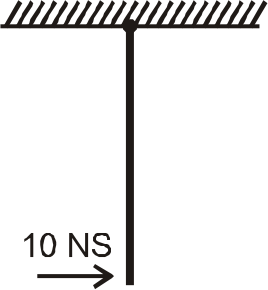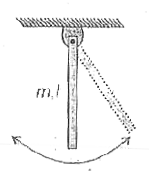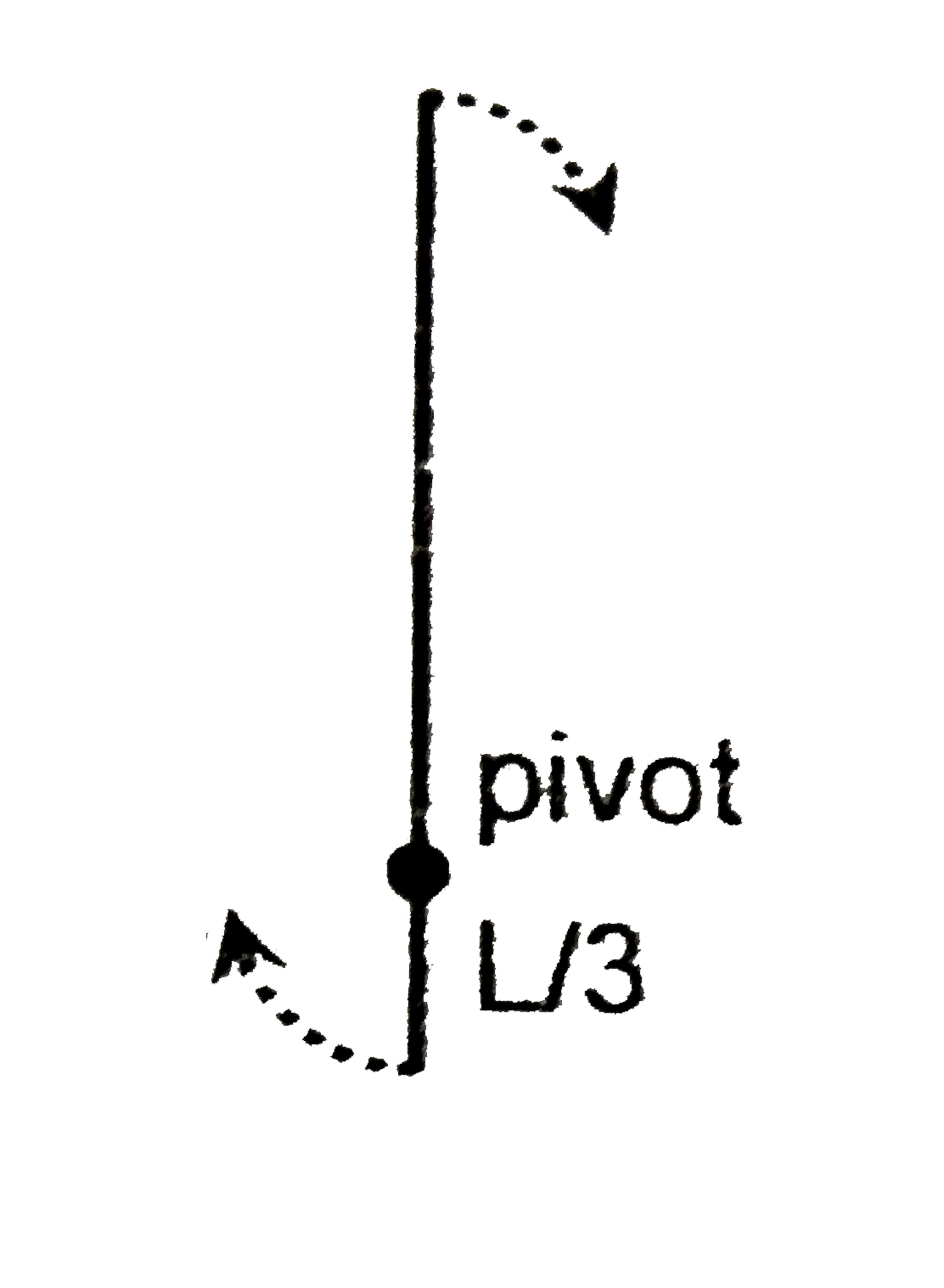A thin unifrom rod of mass m and length l is free to rotate about its upper end When it is at rest. It receives an impulse J as its lowest point, normal to its length immediately after impact.
the angular mumentum of the rod is Jl
The angular velocity of the rod is 3J/ml
The kinetic energy of the rod is 3J2/2m
Linear velocity of the rod at the mid point is 3J//2m
To solve the problem, we will follow these steps:
Step 1: Understand the System
We have a thin uniform rod of mass m and length l that is free to rotate about its upper end. Initially, the rod is at rest. An impulse J is applied at the lowest point of the rod, which is normal to its length.
Step 2: Determine Angular Impulse
The angular impulse ΔL imparted to the rod can be expressed as:
ΔL=J×l
This is because the impulse J acts at a distance l from the pivot point (the upper end of the rod).
Step 3: Relate Angular Momentum to Angular Velocity
Initially, the angular momentum L of the rod is zero since it is at rest. After the impulse is applied, the final angular momentum Lf can be expressed as:
Lf=Iω
where I is the moment of inertia of the rod about the pivot point and ω is the angular velocity.
Step 4: Calculate the Moment of Inertia
The moment of inertia I of a thin uniform rod about an end is given by:
I=13ml2
Step 5: Set Up the Equation for Angular Momentum
From the angular impulse, we have:
J⋅l=I⋅ω
Substituting for I:
J⋅l=(13ml2)⋅ω
Step 6: Solve for Angular Velocity ω
Rearranging the equation gives:
ω=3Jml
Step 7: Calculate Kinetic Energy
The kinetic energy K of the rod in terms of angular velocity is given by:
K=12Iω2
Substituting for I and ω:
K=12(13ml2)(3Jml)2
Simplifying this:
K=12⋅13ml2⋅9J2m2l2=3J22m
Step 8: Find Linear Velocity at Midpoint
The linear velocity v at the midpoint of the rod (which is at l2) can be calculated as:
v=ω⋅l2
Substituting for ω:
v=(3Jml)⋅l2=3J2m
Final Results
1. The angular momentum of the rod is J⋅l.
2. The angular velocity of the rod is 3Jml.
3. The kinetic energy of the rod is 3J22m.
4. The linear velocity of the rod at the midpoint is 3J2m.
Conclusion
All statements provided in the question are correct.
---
We have a thin uniform rod of mass m and length l that is free to rotate about its upper end. Initially, the rod is at rest. An impulse J is applied at the lowest point of the rod, which is normal to its length.
The angular impulse ΔL imparted to the rod can be expressed as:
ΔL=J×l
This is because the impulse J acts at a distance l from the pivot point (the upper end of the rod).
Initially, the angular momentum L of the rod is zero since it is at rest. After the impulse is applied, the final angular momentum Lf can be expressed as:
Lf=Iω
where I is the moment of inertia of the rod about the pivot point and ω is the angular velocity.
The moment of inertia I of a thin uniform rod about an end is given by:
I=13ml2
From the angular impulse, we have:
J⋅l=I⋅ω
Substituting for I:
J⋅l=(13ml2)⋅ω
Rearranging the equation gives:
ω=3Jml
The kinetic energy K of the rod in terms of angular velocity is given by:
K=12Iω2
Substituting for I and ω:
K=12(13ml2)(3Jml)2
Simplifying this:
K=12⋅13ml2⋅9J2m2l2=3J22m
The linear velocity v at the midpoint of the rod (which is at l2) can be calculated as:
v=ω⋅l2
Substituting for ω:
v=(3Jml)⋅l2=3J2m
1. The angular momentum of the rod is J⋅l.
2. The angular velocity of the rod is 3Jml.
3. The kinetic energy of the rod is 3J22m.
4. The linear velocity of the rod at the midpoint is 3J2m.
All statements provided in the question are correct.
Topper's Solved these Questions
- BOOK - DC PANDEY ENGLISHCHAPTER - ROTATIONAL MECHANICSEXERCISE - Level 2 Multiple Correct36videos
ROTATIONAL MECHANICS
- BOOK - DC PANDEY ENGLISHCHAPTER - ROTATIONAL MECHANICSEXERCISE - Level 21videos
ROTATIONAL MECHANICS
- BOOK - DC PANDEY ENGLISHCHAPTER - ROTATIONAL MECHANICSEXERCISE - Level 1 Subjective32videos
ROTATIONAL MECHANICS
- BOOK - DC PANDEY ENGLISHCHAPTER - ROTATIONEXERCISE - (C) Chapter Exercises39videos
ROTATION
- BOOK - DC PANDEY ENGLISHCHAPTER - ROTATIONAL MOTIONEXERCISE - Integer Type Questions17videos
ROTATIONAL MOTION
Similar Questions
A thin uniform straight rod of mass 2 kg and length 1 m is free to rotate about its upper end. When at rest it receives an impulsive blow of 10 Ns at its lowest point, normal to its length as shown in figure. The kinetic energy of rod just after impact is
 View Solution
View SolutionA thin rod of mass m and length l is free to rotate on a smooth horizontal plane about its one fixed end. When it is at rest, it receives a horizontal impulse J at its other end, at angle of 37∘ with the length. Choose incorrect option immediately after impact:
View SolutionA uniform rod of mass m and length l is suspended about its end. Time period of small angular oscillations is
 View Solution
View SolutionA thin uniform rod of length l is pivoted at its upper end. It is free to swing in a vertical plane. Its time period for oscillation of small amplitude is
View SolutionA thin uniform wire of mass m and length l is bent into to shape of a semicircle. The moment of inertia of that wire about an axis passing through its free ends is
View SolutionA thin uniform rod of mass M and length L is free to rotate in vertical plane about a horizontal axis passing through one of its ends. The rod is released from horizontal position shown in the figure. Calculate the shear stress developed at the centre of the rod immediately after it is released. Cross sectional area of the rod is A. [For calculation of moment of inertia you can treat it to very thin]
 View Solution
View Solution
A uniform rod of mass M and length L is free to rotate about a frictionless pivot located L/3 from one end. The rod is released from rest incrementally away from being perfectly vertical, resulting in the rod rotating clockwise about the pivot. when the rod is horzontal what is the magnitude of the tangential acceleration of its center of mass?View SolutionAn impulse J=mv at one end of a stationary uniform frictionless rod of mass m and length l which is free to rotate in a gravity-free space. The impact is elastic. Instantaneous axis of rotation of the rod will pass through
View SolutionA thin bar of mass M and length L is free to rotate about a fixed horizontal axis through a point at its end. The bar is brought to a horizontal position and then released. The axis is perpendicular to the rod. The angular velocity when it reaches the lowest point is
View SolutionA uniform rod of mass m and length L is free to rotate in the vertical plane about a horizontal axis passing through its end. The rod initially in horizontal position is released. The initial angular acceleration of the rod is:
 View Solution
View Solution

